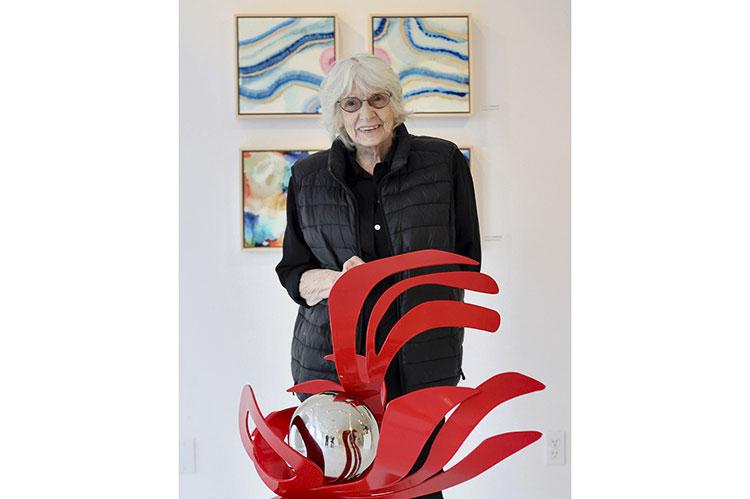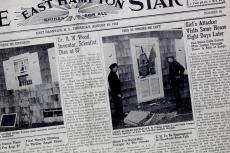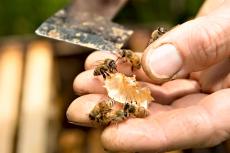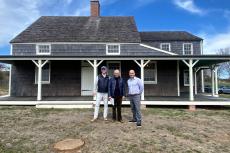The artistic career of Phyllis Hammond of Springs, a sculptor, began almost 90 years ago when, as an 8-year-old, she took a one-hour train trip by herself from Melrose, Mass., to the Museum of Fine Arts in Boston to sketch the Greek and Roman sculptures there. She charted her own course ever since.
When she was 24, for example, divorced and living with her 2-year-old daughter on Cape Cod, Hurricane Carol killed eight of her neighbors. She had to rebuild almost the entire house.
“What I did next was take myself back to the museum school,” she told The Star in a 2016 interview. “I had no formal training. I made a portfolio, was accepted, and once I put my foot in the door it was seven years before I emerged.”
When she did, it was with a one-year travel scholarship to any country in the world. Rather than go somewhere in Europe, at that point still the epicenter of modern art, she opted for Japan.
She was the first American woman to study at the Kyoto City College of Fine Arts, where she further developed her clay and pottery techniques. In 2009 she visited Japan again, to receive the Museum of Greenery, Flowers and Sculpture Prize for her 10-foot piece, “Redefining Space,” in Ube Tokiwa Museum’s International Biennale sculpture competition.
Ms. Hammond’s many awards and achievements include her design of the William Shakespeare Award for Classical Theater. The Will Award, as it is known, has gone to such honorees as Morgan Freeman, Maggie Smith, and Anthony Hopkins. She has also received grants from the National Endowment for the Arts and the Pollock-Krasner Foundation. When she was invited to participate in the Venice Biennale, she declined in order to oversee the installation of her Ube Tokiwa Museum sculpture in Japan.
Phyllis Baker Hammond died on Oct. 23 in Los Angeles. She was 94.
She was born Mary Phyllis Baker in Elizabeth, N.J., on April 13, 1930, to John Willis Baker and the former Margaret McElarney, and grew up in Melrose. She earned a B.A. and M.F.A. from the Boston Museum School, and an education degree from Tufts University.
After moving to New York City, she worked and studied at Greenwich House Pottery. She also worked as a designer of dinnerware at Corning and as a draftswoman at Raytheon. “There were 50 draftsmen there, and only two were women,” she told The Star. “The other woman went to M.I.T.”
Her stoneware was featured in a show at Neiman Marcus, as well as Macy’s in Herald Square, Saks Fifth Avenue, and three Japanese department stores.
Her work came to the attention of galleries in New York and soon earned her solo exhibitions at the Pindar Gallery and 112 Greene Street in SoHo, and Howard Wise on West 57th Street.
In 1985, she married Dr. Aldo Perotto, a professor at the Albert Einstein College of Medicine. That summer, they stayed with his closest friend on Gerard Drive in Springs, and the next year they bought a house of their own on nearby Neck Path. When Dr. Perotto retired in 1995, they sold their year-round house in Briarcliff Manor, N.Y., and moved full time to Springs.
While teaching a class for adults at Pierson High School in Sag Harbor, Ms. Hammond was sent in a new direction as a result of a class project that began with the students drawing lines on large sheets of paper. “I encouraged them to scribble, to experiment. Then they would color in the negative spaces, cut them out, and put them together as paper sculptures.”
That was the genesis of her shift from ceramics to metal. Her sculptures started with spontaneously doodled pencil drawings, which she then redrew in more detail and scanned into a computer. Software converted the drawings into a vector program, which could be read by a waterjet machine that cut the shapes from 4-foot-by-8-foot sheets of aluminum.
She refined the aluminum shapes with a hammer and anvil and took them to Liberty Iron Work in Southampton, where they were fed into a rolling machine. The final step was powder-coating.
Ms. Hammond and her husband moved to a three-acre parcel on Springs-Fireplace Road with a view of Accabonac Harbor in 2000. Charles Forberg, the architect of the LongHouse Reserve, also designed their house, with exterior walls of concrete and cedar.
Her public art commissions included “Beyond the Edge,” five large-scale works for an installation in Dag Hammarskjold Plaza next to the United Nations in 2017, two bronze outdoor sculptures for the Connecticut Commission on the Arts in Hartford, and work on display at the Pratt Institute Sculpture Park in Brooklyn. A retrospective of her work, “Take Flight,” was held at the J. Mackey Gallery in East Hampton in 2023.
In addition to Dr. Perotto, she is survived by two daughters, Sharon Perotto and Lynn Penny; a son-in-law, Harley Weller; a nephew, John Moriarty; a stepson, Oscar Perotto, and his wife, Sylvia Perotto, and a stepdaughter, Claudia Mason. Five grandchildren and six great-grandchildren also survive.
The family held private services at the Getty Center in Los Angeles and on Cape Cod. Burial was at Oak Grove Cemetery in Falmouth, Mass. A public celebration of her life and work will be held in East Hampton next summer.
The family has suggested donations to the Springs Improvement Society, Ashawagh Hall, 780 Springs-Fireplace Road, East Hampton 11937.




